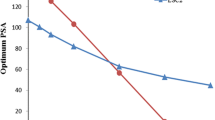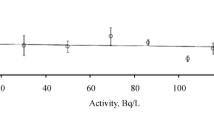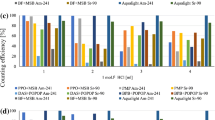Abstract
A portable liquid scintillation counting system based on the triple-to-double coincidence ratio (TDCR) method was developed at Sofia University “St. Kliment Ohridski”. The system consists of a miniature TDCR counter with cylindrical optical chamber and a specialized TDCR counting module named nanoTDCR. The nanoTDCR module is produced by the labZY company and provides several important new TDCR counting functionalities like: individual extending-type dead-time in each channel; simultaneous counting with two different extendable dead-times and two different coincidence windows and simultaneous TDCR counting and spectrum acquisition. The performance of the new system was tested in benchmark comparisons with the LNHB’s primary TDCR counting system of activity measurements of 241Am, 3H, 14C and 63Ni. Good agreement between the two systems was observed.
Similar content being viewed by others
Avoid common mistakes on your manuscript.
Introduction
The triple-to-double coincidence ratio (TDCR) method was developed for the direct determination of the absolute activities of beta- and electron-capture decaying radionuclides in liquid scintillator cocktail ([1], and the references therein). This method is largely used by the National Metrology Institutes (NMIs) for primary standardization [2]. Recently, portable TDCR counters were developed at ENEA (Italy), LNHB (France), NPL (UK) and PTB (Germany) in the framework of the European Metrofission project [3]. These TDCR counting systems differ in their design and in their electronics. However, the portable systems show comparable performance and activity measurement results which are typical of the TDCR metrology instruments used in the NMIs [3]. The developments in the framework of the Metrofission project indicate that it is important to develop portable TDCR counting systems. Portable TDCRs are also found useful for in situ activity measurements and calibrations in nuclear medicine departments in hospitals [4]. This work addresses the challenges of developing a portable TDCR counting system and it is the first application of the TDCR counting method in Bulgaria. In addition, the development of a primary TDCR standardization method in Bulgaria is necessary, because of the wide usage of the liquid scintillation counting (LSC) technique in various fields and to address the needs of the radionuclide metrology.
The objective of this work is to present the design and validation tests of a miniature TDCR counting system developed at the Sofia University “St. Kliment Ohridski”, Bulgaria. The system (hereafter referred to as TDCR-SU) was developed for absolute activity measurements of beta- or alpha- emitters in liquid scintillation (LS) cocktails. It consists of a miniature TDCR counter equipped with dedicated, innovative front-end electronics module (hereafter referred to as the nanoTDCR module). In this work, we present the construction of the TDCR counter, the functionality of the novel nanoTDCR electronic counting module and results from validation comparisons with the French primary TDCR counting system at the Laboratoire National Henri Becquerel (LNHB).
Experimental
The TDCR-SU system consists of an optical chamber, an FPGA-based counting module, a high voltage power supply, and a portable computer (Fig. 1). The system is highly compact and transportable. The major parts of the system, namely the TDCR counter and the nanoTDCR module are described hereafter.
The TDCR-SU counter
The design of the TDCR-SU counter was inspired by the ENEA portable TDCR system [5]. Similarly to that system, the TDCR-SU counter is equipped with three Hamamatsu R7600U-200 square photomultiplier tubes (PMTs), which have small dimensions (30 × 30 mm2), wide spectral response (300–600 nm), high quantum efficiency and relatively low supply voltage (+850 V) [5]. The three PMTs, which are denoted as “A”, “B” and “C”, have a grounded cathode in order to ensure low dark noise [5]. Differently from the ENEA system, which has a triangular optical chamber, the TDCR-SU counter has a cylindrical optical chamber in which the PMTs are fixed at 120 °C, but at a certain distance from the LS vial aiming to achieve a full solid angle view of the vial (Fig. 2). The optical chamber is made of Polytetrafluoroethylene (Teflon®) and the housing is made of Polyoxymethylene (POM). The assembly of the TDCR-SU system is illustrated in Fig. 3. The LS vial is inserted manually in the counter from the lid on the top.
The nanoTDCR electronic counting module
The nanoTDCR electronic counting module is a standalone FPGA-based device dedicated to TDCR measurements (see Fig. 1). It is a scientific development of the labZY company [6] and is currently a commercial product of this company. It has fast input amplifiers (50 Ω adapted) and can be connected directly to the PMT’s anodes. It has fast discriminators, software-adjustable thresholds, stable reference voltage and MCA spectra for threshold adjustment and radionuclide verification. The nanoTDCR module has an external output of the master FPGA clock to allow traceability to the International System of units (SI) of the measured counting rates. The nanoTDCR weighs 135 g and is housed in a very compact enclosure measuring 92 × 38 × 25 mm3.
By design, the nanoTDCR module has similar functionality as the MAC3 TDCR counting module [7], but it also has some distinctive features and additional capabilities such as:
-
Individual extended-type dead-time in each channel instead of one common dead time, as in the MAC3 module;
-
Simultaneous counting with two different dead time extensions (software selectable from 80 ns to 500 µs);
-
Simultaneous counting with two different coincidence windows (software selectable from 8 to 190 ns);
-
Live-time clocks in each channel (single and coincident) for each coincidence window and each dead-time extension;
-
Counters (pulses and associated live-time clocks) for A, B, C, AB, BC, AC, D and T for each coincidence window and each dead-time extension;
-
Online checksum calculation: AB + BC + AC = 2T + D;
-
Capability of simultaneous TDCR counting and spectrum acquisition from a PMT.
Thanks to its capability to perform counting simultaneously by setting two dead-time extensions, two coincidence windows and to acquire a spectrum, a TDCR counter equipped with one nanoTDCR module is able to carry out measurements in an equivalent mode of four MAC3 measurements and also additional measurement for spectrum acquisition. Moreover, the nanoTDCR module can perform consecutive/repetitive runs of fixed real or live time with fixed 30 μs gap between each run. The module is controlled by a software developed by labZY. The software is capable of obtaining UTC from NTP servers with standard metrology grade NTP accuracy in the range from 30 to 50 ms. Thus, each nanoTDCR measurement has an accurate timestamp indicating the start of the measurement. The functionality of the software and its graphical user interface (GUI) are shown in Fig. 4. A detailed description of the algorithms and the principle of operation of the nanoTDCR module are beyond the scope of this work and will be given elsewhere. The Supplementary information to this paper contains more detailed description of:
-
the functionality of the GUI of the nanoTDCR software;
-
the structure of the TDCR data file generated by the nanoTDCR software. In this file the settings and the TDCR measurements are recorded;
-
the web-accessible database, which was developed for storage, filtering and exporting data from the TDCR files. The database is intended to facilitate the TDCR analysis and activity calculations for a large number of TDCR measurements.
Results and discussion
The evaluation of the performance of the TDCR-SU system is done by comparison to the primary TDCR counter (RCTD1) at LNHB. The correct operation of the nanoTDCR module is first verified by comparison with the MAC3 TDCR module. The thresholds of the PMTs of the TDCR-SU counter are then set in the valley between the single photon peak and the noise peak using the nanoTDCR MCA functionality. The entire TDCR-SU system is then benchmarked against the LNHB’s RCTD1 system by TDCR counting and analysis of 241Am, 3H, 14C and 63Ni sources.
Evaluation of the performance of the nanoTDCR counting module
As a preliminary test, the nanoTDCR counting module was first compared to the MAC3 counting module, using the RCTD1 counter. The logical outputs of the constant fraction discriminators of the RCTD1 system were connected to the nanoTDCR inputs and simultaneous counting with the MAC3 and nanoTDCR units was performed. Four 241Am samples with Ultima GoldTM with activities in the 480–4600 Bq interval were used. A comparison of the obtained results is given in Table 1, showing a good agreement between the MAC3 and nanoTDCR counting results. The differences are smaller than 0.3% and can be attributed to the different live times of the two systems.
Adjustment of the thresholds of the TDCR-SU system
The proper operation of a TDCR counting system requires the precise adjustment of the thresholds in the valley between the noise peak and the single electron peak (SEP) observed in each channel. In this work the adjustment was performed using the MCA functionality of the nanoTDCR module. The PMTs were operated at +850 V anode voltage and the SEP spectra were acquired without any source in the counter. Figure 5 depicts the SEP spectra acquired with the nanoTDCR with low, optimal and high thresholds. Based on the results from the performed studies, the determined optimal thresholds are 3.6, 4.0 and 4.0 mV for the PMTs A, B and C, respectively.
Comparison between the RCDT1 and TDCR-SU systems
The second part of the comparison was performed with the four 241Am sources mentioned earlier. The sources were measured on the RCTD1 system and then on the TDCR-SU system for 10 min counting time. The results are shown in Table 2. Taking into account the statistical uncertainties of the measurement, there is an excellent agreement between RCTD1 and TDCR-SU for sources No 1 and 2, good agreement for source No 3 and a satisfactory agreement for source No 4. The differences between the two counting systems are smaller than 0.3% and do not show a systematic trend, which indicates a linear response of the TDCR-SU system for counting rates in the interval 480–4600 s−1.
In the third test the performance of the TDCR-SU counter was compared to the performance of the LNHB’s RCTD1 counter by primary TDCR measurements of 3H, 14C and 63Ni sources (Table 3). The activities of the 3H, 14C and 63Ni sources were determined from the measured T/AB, T/AC, T/BC coincidence ratios using the TDCR07c program [8]. Same cocktail data and kB values were used in the calculations for the RCTD1 and TDCR-SU systems. Excellent agreement between the two systems was observed for the 3H and 14C sources within the estimated uncertainties. The agreement for the 63Ni source is not as good as for the two previous radionuclides, due to the low counting statistics, but the results are still compatible if expanded uncertainties (k = 2) are considered. The performance of the TDCR-SU system in the case of 63Ni will be studied in the future with measurements with very low counting uncertainties in order to reduce random fluctuations and to study the influence of the 63Ni beta- spectrum.
The LNHB’s primary TDCR system RCTD1 is equipped with BURLE 8850 PMTs which are cylindrical with a 51 mm diameter photocathode. The TDCR-SU system is equipped with Hamamatsu R7600U-200 PMTs, which are 30 × 30 mm square PMTs. The two systems have different optical chambers. It is therefore particularly interesting to compare the two systems in terms of the counting efficiency for the logical sum of the double coincidences (D). The comparison was performed with three sources: 3H in toluene- based LSC, 14C in toluene-based LSC and 63Ni in Ultima Gold AB. The results of the comparison are shown in Table 4 and they indicate lower efficiency of the TDCR-SU system with respect to the LNHB TDCR one. The differences increase with the decrease of the maximum energy of the beta- spectrum of the nuclides (E β,max). The lower efficiency of the TDCR-SU system compared to the RCDT1 system may be due to: lower light collection of the TDCR-SU system because of the smaller photocathode or light loses due to the larger distance of the TDCR-SU PMTs from the vial. Nevertheless, based on the estimated counting efficiency of the TDCR-SU for the logical sum of double coincidences (ε D ), the TDCR-SU system demonstrates excellent performance as an ultra-compact and portable TDCR counting system.
Conclusions
A novel, miniature TDCR counting system was developed at the Faculty of Physics of Sofia University (Bulgaria) and validated thanks to a comparison with the TDCR LNHB counter. A new acquisition module and acquisition software for TDCR counting were developed. The nanoTDCR module offers variety of useful new features and allows performing TDCR measurements with traceability to time and frequency units.
The performance of the TDCR-SU counting system was benchmarked against the LNHB’s primary TDCR system for activity measurements of 241Am, 3H, 14C and 63Ni sources. Good agreement was observed between the results of the two measurement systems.
All in all, the new TDCR-SU counting system exhibits a good performance in particular due to its low weight and compactness and its extended possibilities for detector adjustments and data acquisition. It could be used as portable instrument for on-site measurements, e.g. for very short-lived radionuclides used in nuclear medicine.
References
Malonda G, Carles G, L’Annunziata M (2012) Handbook of radioactivity analysis, vol 3. Academic Press, Amsterdam
Broda R, Cassette P, Kossert K (2007) Radionuclide metrology using liquid scintillation counting. Metrologia 44:S36–S52
Cassette P, Capogni M, Johansson L, Kossert K, Nähle O, Sephton J, De Felice P (2013) Development of portable liquid scintillation counters for on-site primary measurement of radionuclides using the triple-to-double coincidence ratio method. In: Proceedings of the 3rd International Conference on Advancements in Nuclear Instrumentation, Measurement Methods and their Applications (ANIMMA), Marseille, 2013, doi 10.1109/ANIMMA.2013.6727876
Donatiello S, Capogni M, De Felice P, Cannatà V, D’Arienzo M, Strigari L, Tapner M (2016) Absolute measurement in situ of the 90Y activity in liquid solution by TDCR method and calibration of an ionization chamber. Phys Med 32:e104
Capogni M, De Felice P (2014) A prototype of a portable TDCR system at ENEA. Appl Radiat Isot 93:45–51
Triple-to-double coincidence ratio liquid scintillation counting system (TDCR) and MCA, http://www.labzy.com/index.html#nanoTDCR. Accessed 24 May 2017
Bouchard J, Cassette P (2000) MAC3: an electronic module for the processing of pulses delivered by a three photomultiplier liquid scintillation counting system. Appl Radiat Isot 52:669–672
Detection efficiency calculation for pure-beta radionuclides, LNHB program with short tutorial, 2012 version, TDCR07c.zip: http://www.nucleide.org/ICRM_LSCWG/icrmsoftware.htm. Accessed 24 May 2017
Acknowledgements
This work is supported by the Bulgarian National Science Fund under Contract DFNI T02/13”POLYRAD”. The authors are indebted to Mr. Nikolay Markov and Mr. Todor Todorov for the mechanical work on the TDCR counter, which was manufactured and assembled in Bulgaria.
Author information
Authors and Affiliations
Corresponding author
Electronic supplementary material
Below is the link to the electronic supplementary material.
Rights and permissions
About this article
Cite this article
Mitev, K., Cassette, P., Jordanov, V. et al. Design and performance of a miniature TDCR counting system. J Radioanal Nucl Chem 314, 583–589 (2017). https://doi.org/10.1007/s10967-017-5451-3
Received:
Published:
Issue Date:
DOI: https://doi.org/10.1007/s10967-017-5451-3









